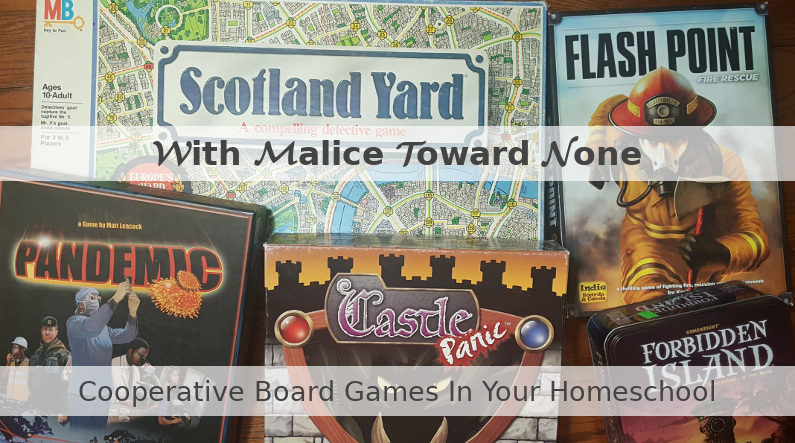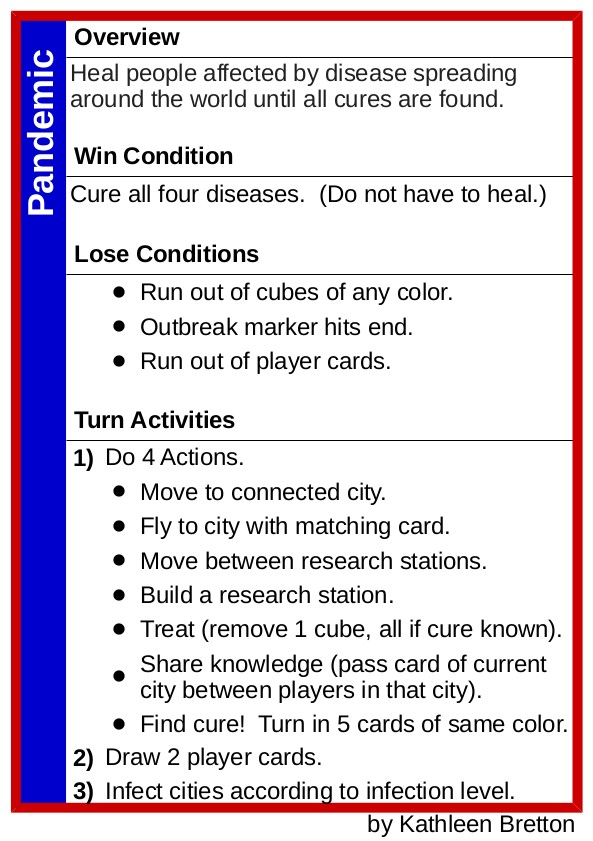With Malice Toward None: Cooperative Board Games In Your Homeschool
by Kathleen Bretton
What Are Cooperative Games?
Board games are a great way for families to spend time together, but it can be hard to find a game that makes children of various ages happy. With many games, your 14-year-old is bored with its simplicity while your 5-year-old is frustrated with always losing. One great solution is cooperative board games.
In a cooperative board game, all players collaborate to beat the game. There may be a timer counting down (e.g. Break the Safe) or, more commonly, a limited resource whose depletion signals the end of the game. Each player is an individual who controls a single pawn, deck and/or other resource(s). But, all players discuss how to achieve their common goal(s) and coordinate their actions accordingly. For instance, I may give you a card I’ve collected so you can make a complete set or you may use your helicopter on your turn to move my pawn where we’d like me to be at the start of my next turn. So, the 5-year-old gets to take her turn and participate in the game, while the 14-year-old gets to bring his experience into play and guide her.
Recommendations
Below, I’ve put together an overview of some games in this genre. Some of these indicate a maximum of four players, but, as everyone is cooperating anyway, it’s not too much of a stretch to have a couple of children play the same character. While some games indicate minimum ages, these are somewhat inflated in my opinion because they can be played by many younger children. If your child plays a lot of games, is especially smart or reads above their grade-level, then you could push down these ages by at least a couple of years. Also, in a cooperative board game older players will be very involved in helping direct the actions of the younger players, so those younger players can play a more difficult game than they might otherwise be able to.
| Pandemic | ||
|---|---|---|
| Theme | We must find the cure to four diseases that are spreading throughout the world while tending to those already sick. | 
|
| Overview | Every turn, we draw an number of cards with city names on them, spreading the infection to more cities or worsening the infection to an already-infected city. (Throughout the game, the number of cards we draw increases periodically.) If a city gets too bad, the infection explodes to neighboring cities. If we have enough of these explosions (outbreaks), the game ends. The game also ends when the supply of player cards or infection cubes runs out. When we collect five matching cards from one of four regions of the world, we can turn them in and have found the cure. When we’ve done that with all four regions, we win! | |
| Reading | Both decks of cards have city names that must be matched to the board. Non-readers can be helped by fellow players, though it may be frustrating for them as finding the cities is a big part of making each move. | |
| Notes | Created by the same designer as Forbidden Island (below), Pandemic is very similar, though a bit more complex. This title has been popular for years and can be found at some big box retailers. I created a Pandemic Player Aid for this game that you may find useful in understanding and/or playing it. |
|
| Players | 2-4 (5 with On the Brink expansion) | |
| Ages | 8+ | |
| Time | 45 min | |
| Cost | $22-40 | |
| Forbidden Island | ||
| Theme | We must keep an island from sinking long enough to gather all four treasures and leave. |  |
| Overview | Just as in Pandemic, cards are drawn every turn to affect tiles. The first time a tile is affected, it sinks just a little bit. We can spend our efforts to shore up sinking tiles, thus keeping them on the island. If a partially-sunk tile has its card drawn a second time – and it hasn’t been shored up in the meantime – it and its marching card are removed from the game. Players are slowly collecting cards which have pictures of the treasures on them. When one player has gathered four matching cards, he can save that treasure and we’re one step closer to our goal. | |
| Reading | Cards flipped over have to be matched to tiles on the island. This can be done by matching pictures or having other players flip the tiles. There are a few different action cards with text mixed in the deck, but, as this is a cooperative, they can have help reading their text. Once they’ve played a few times, they will know the cards by their pictures. | |
| Notes | This title is probably the easiest to learn if you haven’t ever played a hobby board game. It’s also readily available at many retail stores. | |
| Players | 2-4 | |
| Ages | 10+ | |
| Time | 60-80 m | |
| Cost | $12-20 | |
| Flash Point: Fire Rescue | ||
| Theme | We must fight a fire spreading throughout a house as we try to rescue seven victims within the house. |  |
| Overview | On every players turn, the fire spreads. At first, it’s just smoke, but, if the smoke hasn’t been dealt with on that spot, it becomes fire the next time that spot is randomly picked. If that spot is picked again, it blows up and catches fire to surrounding areas and/or knocks down neighboring walls. A fire will also ignite neighboring smoke. Meanwhile, we are trying to get to and rescue victims caught within the fire. We must balance our fire-fighting efforts with our life-saving efforts to be victorious. | |
| Reading | None. | |
| Notes | A two-sided board and two-levels of play help this game stay fresh through many plays. Several expansions are available as well. | |
| Players | 1-6 | |
| Ages | 10+ | |
| Time | 45 min | |
| Cost | $27-30 | |
| Castle Panic | ||
| Theme | We must fight off advancing hordes of monsters to prevent our castle keep from falling. |  |
| Overview | Our castle (well, ring of keeps surrounded by crenulated walls) is surrounded by an open area and, then, a forest. Monsters appear in the forest, then advance through the terrain towards our castle. Our archers who are best able to fight monsters off when they’re fresh out of the forest. However, when they are a bit closer, it’s our knights who ride out to arrest their advance. By the time they are at the walls, our swordsmen are our best defense. If we fail to vanquish them before they arrive at our walls, our walls and, then, our keeps begin to be lost. Lost walls can be re-built, but lost keeps cannot. When we lose our last keep, we lose the game. We win the game if we have at least one keep still standing when the last monster is killed. Our soldiers are further limited by (usually) only being able to fight in their (blue, green or red) 1/3 of the board. Sometimes the tricky monsters move sideways, so that blue swordsman we’d plan to send out after the next monster advance is suddenly useless as the monsters have moved to a red area. | |
| Reading | Some reading, but doable with help from teammates. | |
| Notes | Fantasy theme with some references to magic. | |
| Players | 1-6 | |
| Ages | 10+ | |
| Time | 60 min | |
| Cost | $19-30 | |
| Scotland Yard | ||
| Theme | We are trying to corner bad guy Mr. X (played by one of us!) on a map of London. |  |
| Overview | We are all moving around a map of London filled with labelled spaces (nodes, really). We detectives start on a known node with a certain number of tokens for riding a taxi, a bus or the Underground. Every node is serviced by taxis and one token advances you one node. Buses stop less frequently, connecting nodes one to three sections apart. Underground trains stop the least and connect notes three to five sections apart. Meanwhile, dastardly Mr. X moves secretly around the board with an unlimited number of tokens. He also can take the water taxis and twice take a double turn. However, he must reveal to us where he is on his 3rd, 8th, 13th, 18th and 24th turns. Then, we detectives coordinate our moves to try to tighten the noose around him. If we haven’t caught Mr. X when he’s out of moves, he escapes! | |
| Reading | Very little. The transportation tokens match their colored routes on the board. Non-readers will have to be shown where Mr. X is (the five times he surfaces) if they can’t read numbers. | |
| Notes | As Mr. X is a character played by someone, this is a great opportunity for Dad or the oldest sibling to pit themselves against the rest of the family. Sometimes, in cooperatives, a big personality can control the game too much. That’s who gets to be Mr. X in Scotland Yard. | |
| Players | 3-6 | |
| Ages | 10+ | |
| Time | 45 min | |
| Cost | $21-40 | |


Recent Comments